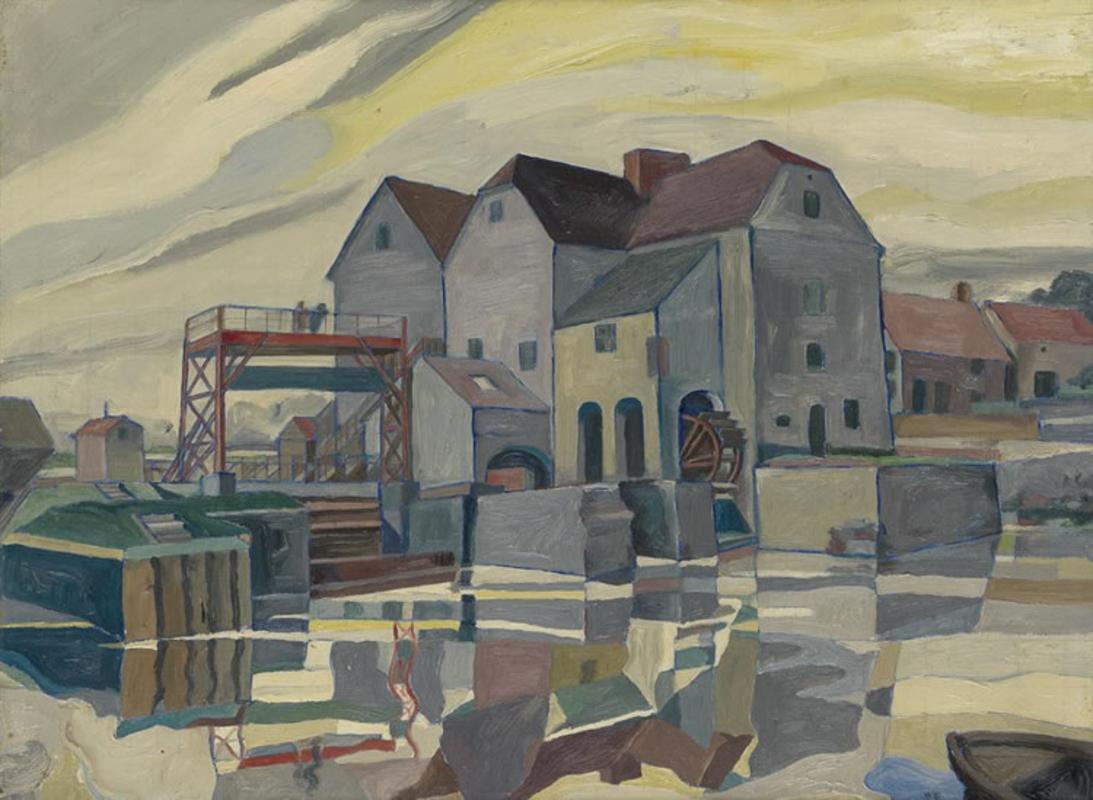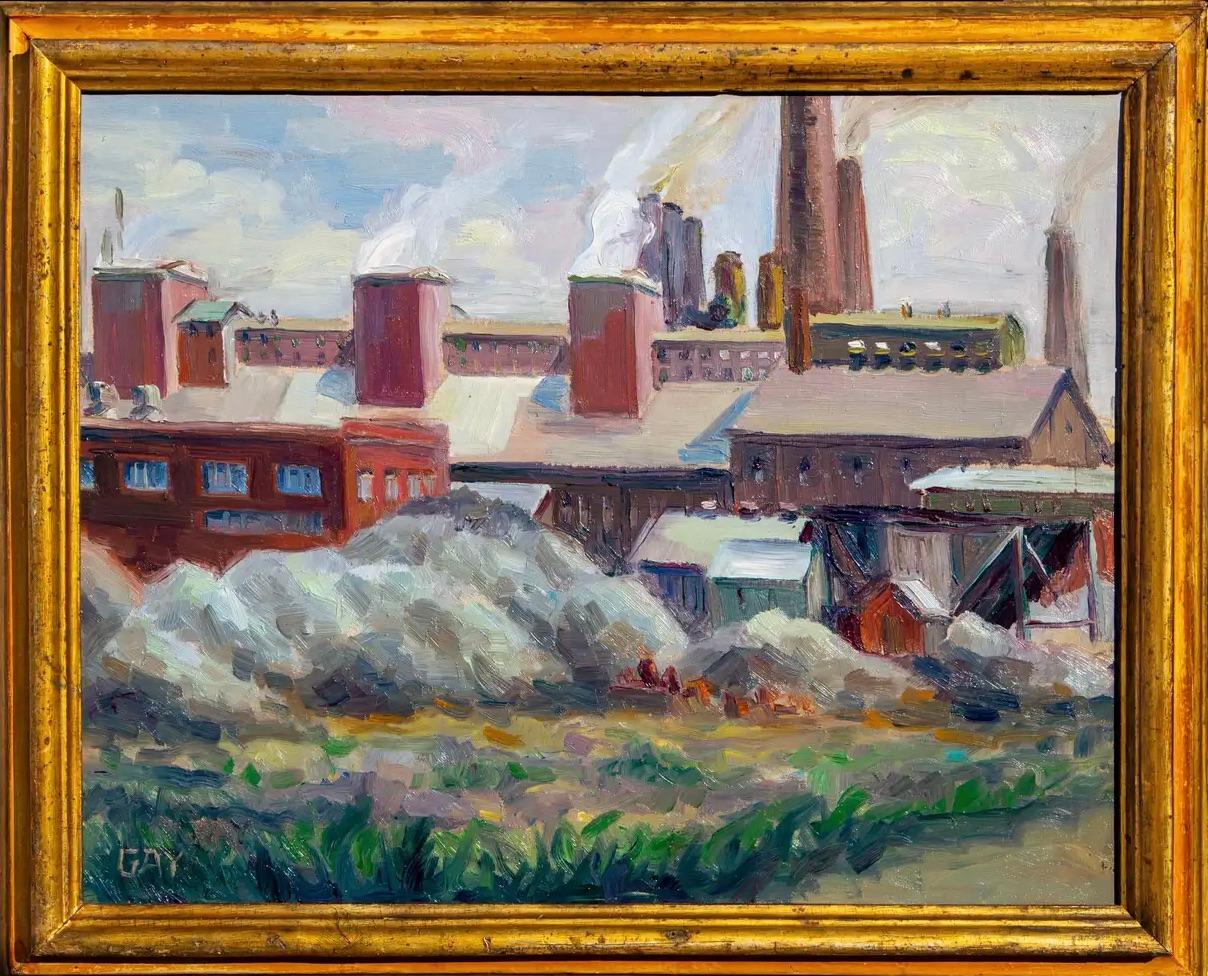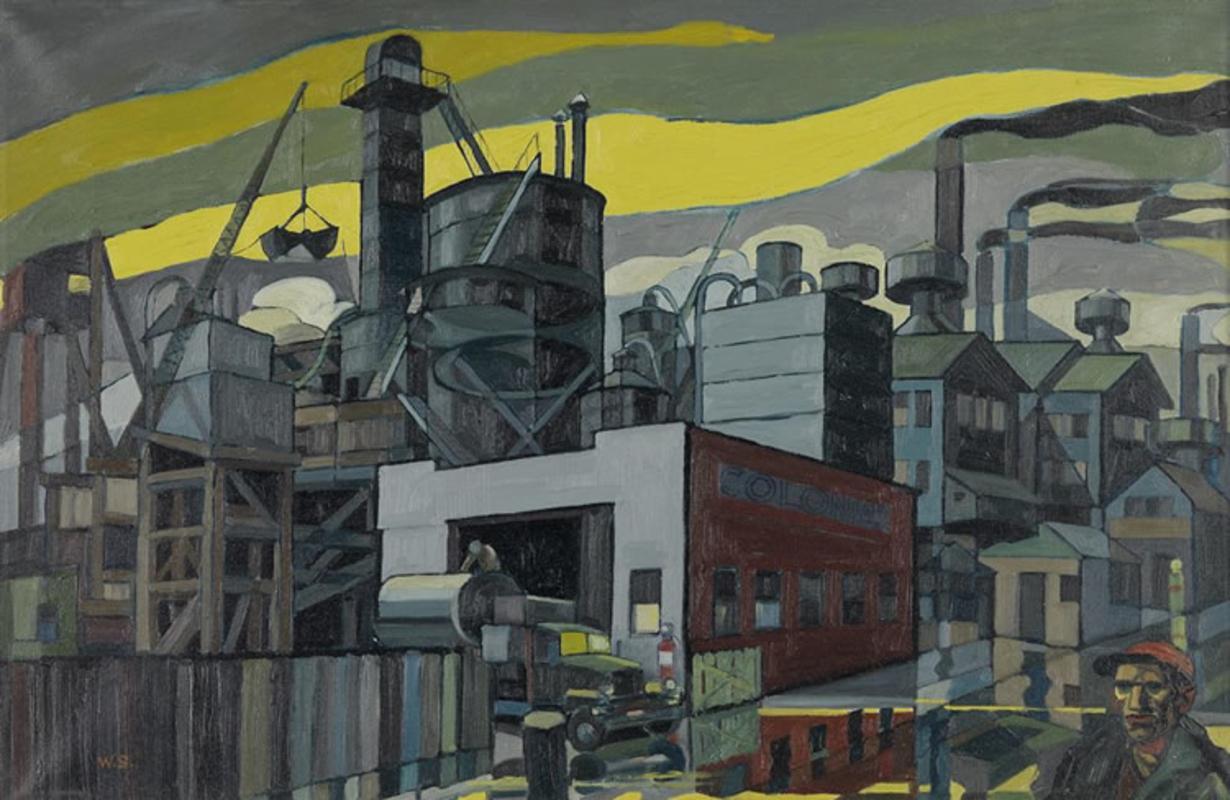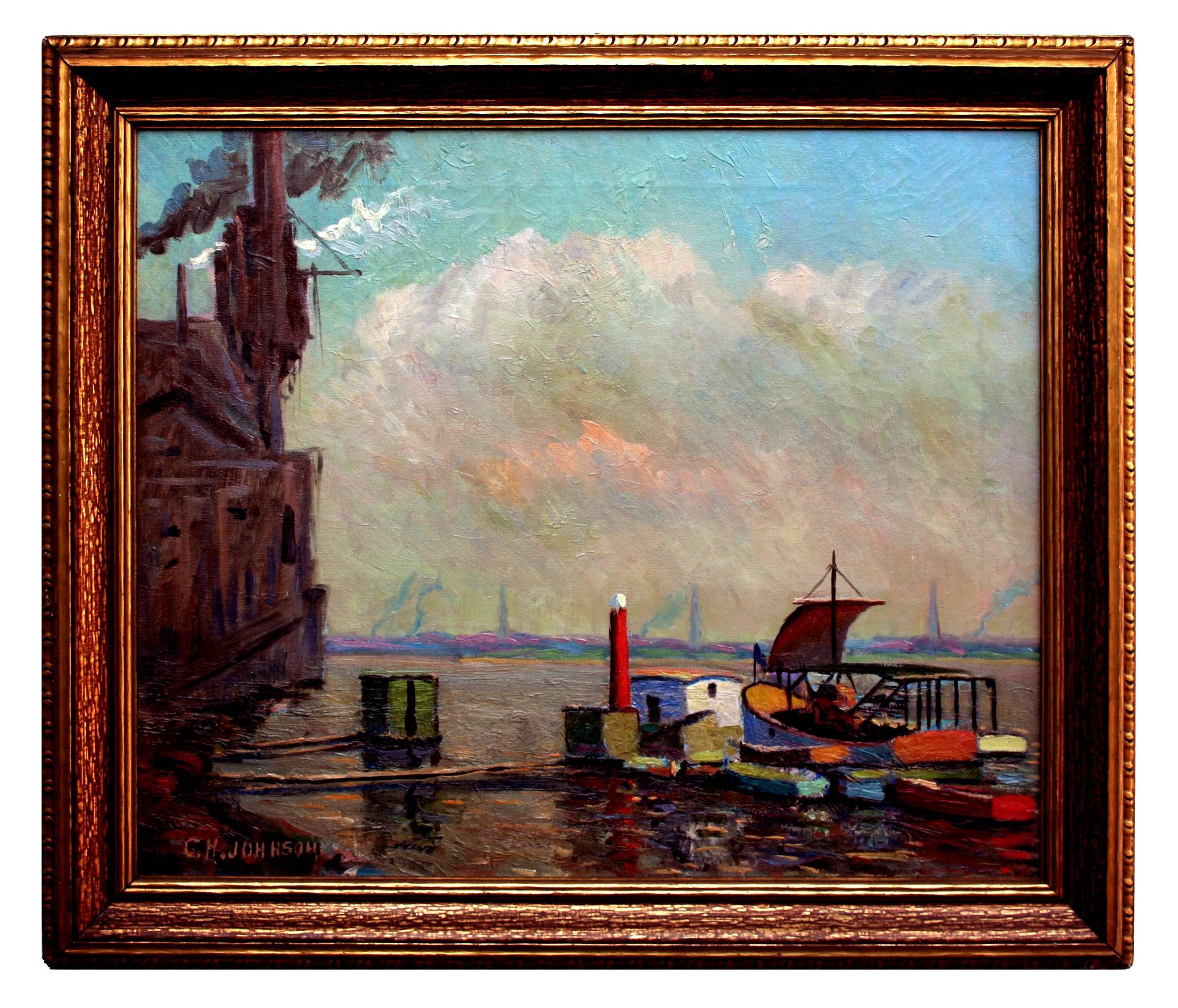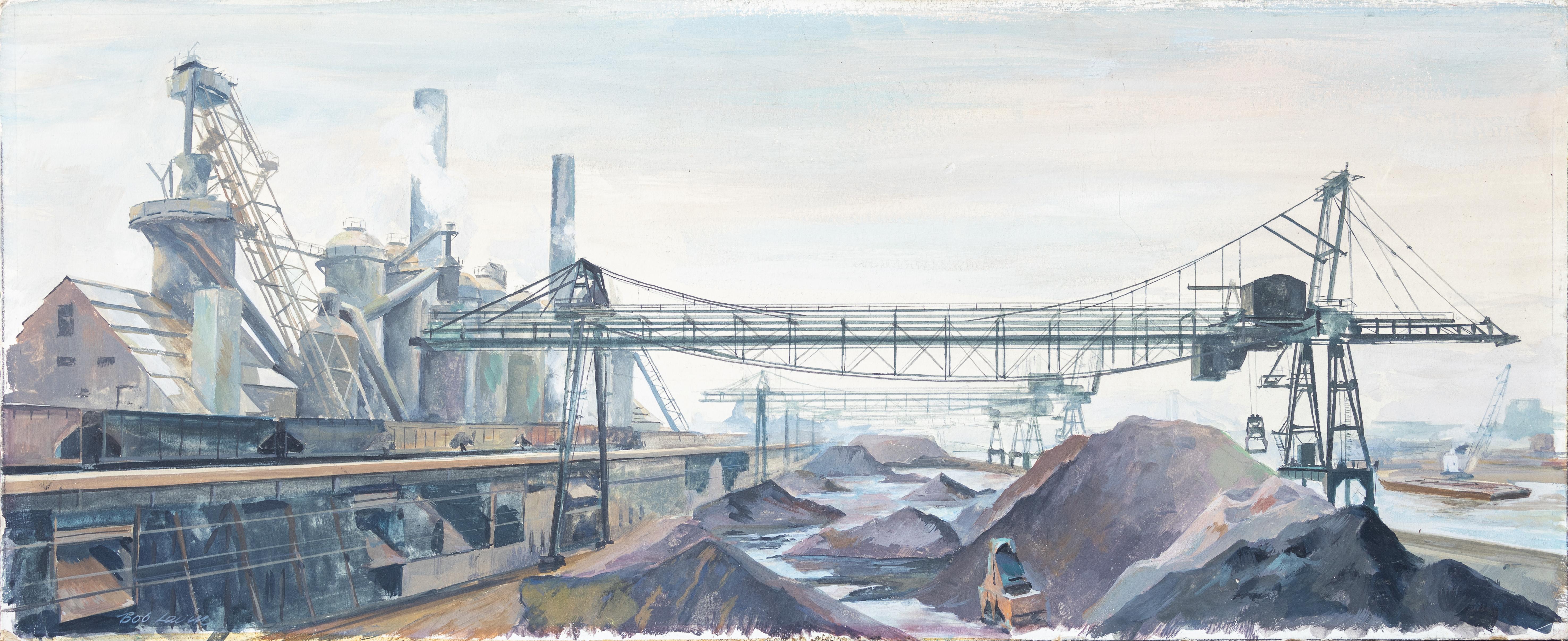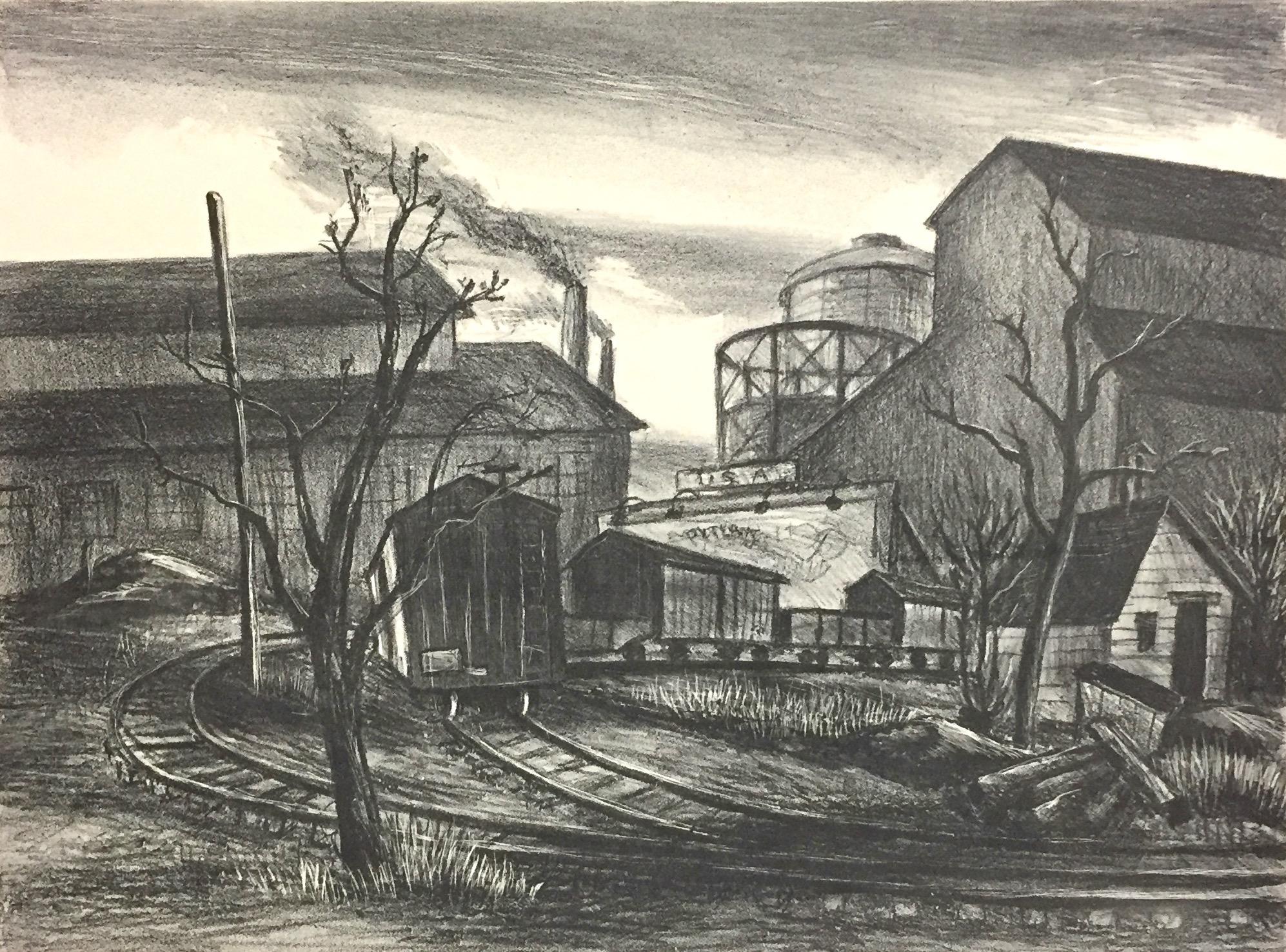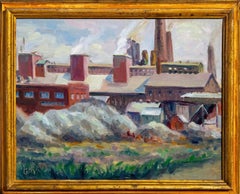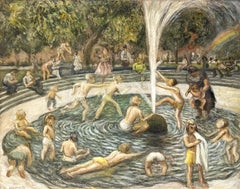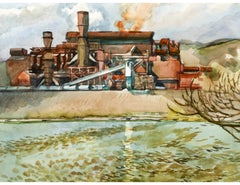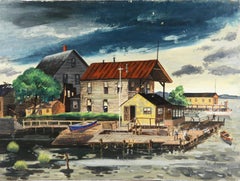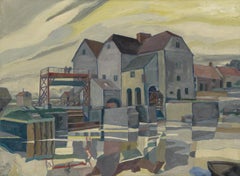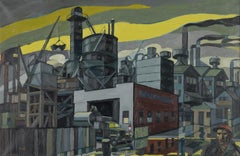Items Similar to Boys Swimming Industrial Landscape WPA Mid 20th Century Social Realism Modernism
Want more images or videos?
Request additional images or videos from the seller
1 of 7
Henry Ernst SchnakenbergBoys Swimming Industrial Landscape WPA Mid 20th Century Social Realism Modernism1940s
1940s
$2,900
£2,181.98
€2,520.88
CA$4,098.46
A$4,450.13
CHF 2,356.67
MX$54,545.82
NOK 29,164.70
SEK 27,559.09
DKK 18,814.80
About the Item
Boys Swimming Industrial Landscape WPA Mid 20th Century Social Realism Modernism
Henry Schnakenberg (1982 - 1970)
Boys Swimming Industrial Landscape
11 1/2 x 15 1/2 sight
Oil on Canvas
Signed lower left
14 1/2 x 18 1/2 inches, Framed
Bio
In many cases, American artists visited the Armory Show in New York in 1913, and returned to their studios to react to or against what they saw. However, for Henry Ernest Schnakenberg it was much more life altering. Prior to visiting this important exhibition of American and European modernist art, he had been working as an insurance sales representative for his father's firm. After seeing the Armory Show, he was inspired to go to art school.
He enrolled at the Art Students League where he had the good fortune to have both John Sloan and Kenneth Hayes Miller as teachers. His fellow students at that time were Yasuo Kuniyoshi, Peggy Bacon, Alexander Brook and Niles Spencer. (1) After serving in the army, he returned to New York and began to paint independently, and in 1921, he had his first show at the Whitney Studio Club along with Joseph Stella.
He taught at the Art Students League from 1923 to 1925. Schnakenberg's esteem and standing at the School were fully affirmed when he was elected president in 1932, and he was to remain a life long member. He was later awarded an honorary degree from the University of Vermont. Throughout his career, Schamberg wrote critical essays and reviews for art magazines, primarily The Arts. (2)
Not surprising, as a young painter, Schnakenberg tried many directions with his art: landscapes, still lifes, portraits and genre paintings all with superb attention to detail and depth of feeling for his subject. His teachers at the Art Students League probably played the most influential role in shaping his career with their emphasis on the urban scene and realism with more or less gritty details related to Everyday City life.
Early on, he caught the attention of Lloyd Goodrich, then director of the Whitney Museum of American Art. Goodrich observed of Schnakenberg's art, "Schnakenberg is a patient, steady builder rather than a brilliant improviser. His pictures are the result of careful thought and planning. Nothing is slurred over or left vague; every detail is precise." (3)
During the 1920s, Schnakenberg traveled widely but spent some of most summers in Manchester, Vermont, and usually winters in New York. He was a founder of the Southern Vermont Artists Association, and later he founded an art gallery in the local library for local artists to have exhibition space when he moved to Newtown, Connecticut. He was an avid collector of pre-Columbian and Oriental sculpture, and he acquired the work of his contemporaries, such as Winslow Homer, Sloan, George Luks, William Glackens and Theodore Stamos. (4)
Lloyd Goodrich, in his important text, American Art of Our Century (1961), summed up Schnakenberg's career and devoted an entire paragraph to him. He declared him to be an individualist from the first with a goal to build images of reality that are "satisfying for both their associations and forms," rather than attempt to express subjective emotion. (5)
Schnakenberg won numerous awards and exhibited nationally. His work may also be found at the Whitney Museum of Modern Art, Metropolitan Museum of Art, Wadsworth Atheneum, Brooklyn Museum, Pennsylvania Academy of Fine Arts, Yale University Art Museum and the Art Institute of Chicago.
- Creator:Henry Ernst Schnakenberg (1892 - 1970, American)
- Creation Year:1940s
- Dimensions:Height: 15 in (38.1 cm)Width: 19 in (48.26 cm)
- Medium:
- Movement & Style:
- Period:
- Condition:
- Gallery Location:New York, NY
- Reference Number:1stDibs: LU1156213941572
About the Seller
5.0
Gold Seller
Premium sellers maintaining a 4.3+ rating and 24-hour response times
Established in 2008
1stDibs seller since 2019
195 sales on 1stDibs
Typical response time: <1 hour
- ShippingRetrieving quote...Shipping from: Pawling, NY
- Return Policy
Authenticity Guarantee
In the unlikely event there’s an issue with an item’s authenticity, contact us within 1 year for a full refund. DetailsMoney-Back Guarantee
If your item is not as described, is damaged in transit, or does not arrive, contact us within 7 days for a full refund. Details24-Hour Cancellation
You have a 24-hour grace period in which to reconsider your purchase, with no questions asked.Vetted Professional Sellers
Our world-class sellers must adhere to strict standards for service and quality, maintaining the integrity of our listings.Price-Match Guarantee
If you find that a seller listed the same item for a lower price elsewhere, we’ll match it.Trusted Global Delivery
Our best-in-class carrier network provides specialized shipping options worldwide, including custom delivery.More From This Seller
View AllBuffalo, NY Steel Mill American Scene Modernism WPA Era Industrial 20th Century
Located in New York, NY
Buffalo, NY Steel Mill American Scene Modernism WPA Era Industrial 20th Century
Ruth A. Haven Gay (1911-1992)
“Buffalo, NY Steel Mill”, c. 1935
23 x 28 inches
Oil on canvas
Signed G...
Category
1930s American Modern Landscape Paintings
Materials
Oil, Canvas
Bathers 1940s Mid 20th Century American Scene Social Realism WPA Modern Ashcan
Located in New York, NY
Bathers 1940s Mid 20th Century American Scene Social Realism WPA Modern Ashcan
Marion Gilmore (1909-1984)
Bathers
15 1/2 x 19 1/2 inches
oil on canvas boar...
Category
1940s American Realist Figurative Paintings
Materials
Oil, Board
Industrial Landscape Contemporary American Watercolor Magic Realism 20th Century
By Henry Koerner
Located in New York, NY
Industrial Landscape Contemporary American Watercolor Magic Realism 20th Century
Henry Koerner (1915-1991)
J&L Oxygen Plant
18 x 24 1/2 inches
Watercolo...
Category
1980s American Realist Landscape Drawings and Watercolors
Materials
Paper, Watercolor
"Summer Pier Fishing" American Scene Social Realism WPA Mid-20th Century Modern
Located in New York, NY
"Summer Pier Fishing" American Scene Social Realism WPA Mid-20th Century Modern
Syd J. Browne (1907-1991)
"Summer Pier Fishing"
22 x 30 inches
Oil on canvas. c. 1930s
Signed lower r...
Category
1930s American Realist Figurative Paintings
Materials
Canvas, Oil
"Industrial Cityscape, Chicago" WPA Modernism Mid-Century Cityscape 20th Century
By Aaron Bohrod
Located in New York, NY
"Industrial Cityscape, Chicago" WPA Modernism Mid-Century Cityscape 20th Century
Aaron Bohrod (American 1907 – 1992)
Industrial Cityscape
20 x 16 inches
Oil on board
Signed lower ri...
Category
1930s American Modern Landscape Paintings
Materials
Oil, Board
"Cubist Factory" American Scene WPA Social Realism Mid 20th Century Industrial
Located in New York, NY
"Cubist Factory" American Scene WPA Era Social Realism Mid 20th Century Industrial
Herbert Heyel (American 1907-2000)
"Cubist Factory"
14 x 20 inches
Watercolor on paper, c. 1933
S...
Category
1930s American Realist Landscape Drawings and Watercolors
Materials
Paper, Watercolor
You May Also Like
"Factory on the River" Modernist and Precisionist WPA Industrial New York Scene
By William Sharp
Located in New York, NY
William Sharp (1900 - 1961)
Factory on the River
Oil on canvas
17 1/2 x 23 1/4 inches
Initialed lower right: WS
Provenance:
Estate of the artist
Private Collection, New York
Swann Auction Galleries, American Art, June 13, 2019, Lot 178
William Sharp was born on June 13, 1900, in Lemberg, Austria, where he attended college and the Academy for Arts and Industry. He later studied in Kraków, Poland, and in Berlin and Munich, Germany. Sharp began his career as a designer of stained-glass windows and as a painter of murals. He served in the German army during World War I. After the war he became a newspaper artist in Berlin and a well-known etcher.
Sharp drew political cartoons that were bitterly critical of the growing Nazi movement. As the influence of National Socialism intensified, he began to contribute drawings, under a pseudonym, to publications that were hostile to Hitler. After Hitler assumed power, Sharp was confronted with these drawings and told that he would be sent to a concentration camp. However, in 1934, he escaped to the United States.
His first newspaper assignment in America was making courtroom sketches for The New York Mirror...
Category
Mid-20th Century American Realist Landscape Paintings
Materials
Canvas, Paint, Oil
"Colonial Sand and Stone Company, New York, " Industrial WPA Scene, Precisionist
By William Sharp
Located in New York, NY
William Sharp (1900 - 1961)
Factory on the River
Oil on canvas
20 1/2 x 28 1/2 inches
Initialed lower left: WS
Provenance:
Estate of the artist
Private Collection, New York
Swann Auction Galleries, American Art, June 13, 2019, Lot 178
Private Collection, New York
Colonial Sand and Stone Co., founded by Generoso Pope, was once the country’s largest sand and gravel business, providing the concrete for much of New York City’s skyline, including the Empire State Building, Rockefeller Center, Radio City Music Hall, airports and subways.
William Sharp was born on June 13, 1900, in Lemberg, Austria, where he attended college and the Academy for Arts and Industry. He later studied in Kraków, Poland, and in Berlin and Munich, Germany. Sharp began his career as a designer of stained-glass windows and as a painter of murals. He served in the German army during World War I. After the war he became a newspaper artist in Berlin and a well-known etcher.
Sharp drew political cartoons that were bitterly critical of the growing Nazi movement. As the influence of National Socialism intensified, he began to contribute drawings, under a pseudonym, to publications that were hostile to Hitler. After Hitler assumed power, Sharp was confronted with these drawings and told that he would be sent to a concentration camp. However, in 1934, he escaped to the United States.
His first newspaper assignment in America was making courtroom sketches for The New York Mirror...
Category
Mid-20th Century American Realist Landscape Paintings
Materials
Canvas, Paint, Oil
Mid Century Industrial Seascape -- Gloucester Harbor
By Charles Johnson
Located in Soquel, CA
A detailed mid century industrial seascape of Gloucester, MA Harbor scene with boats and the Old Paint Works by Charles Johnson (American, b. 1874), c. 1940. Signed lower left corner...
Category
1940s Modern Paintings
Materials
Canvas, Oil
$2,000 Sale Price
20% Off
"Shipyard" Realist Industrial Landscape
By Robert Lavin
Located in Austin, TX
This painting is a 20th century realist landscape depiction of a shipyard by Robert Lavin. The piece is executed in oil on board and measures 10" x 24".
Robert Lavin was born in New York City. His education included Townsend Harris, a prep school in New York followed by college at City College of New York. He also attended the National Academy of Art, where he studied as a painter. Studying the social realists of the 1930’s, Lavin, a former Marine pilot, portrayed steelworkers, roughnecks and trainmen. Lavin often painted his “proletarian ballets”- as one critic called them – to illustrate magazine advertisements.
The Smithsonian Institution and other museums collected Lavin’s original paintings, which portrayed the laboring subjects with dignity and integrity. Lavin also illustrated stock certificates and books. Paper Money magazine praised him as “one of the greatest vignette artists of the 20th century.” In addition to this, Lavin was for a number of years an Associate Professor of Art at City College of New York, a position he left in the mid ‘60’s in order to devote himself full time to his painting. His commissions took him around the world, from the North Sea to the coast of Africa, from the slopes of Alaska to the Sea of Japan. As part of a series for Gulf Oil, he painted the royal family of England for the opening of a new refinery in Wales. Another portrait of one of the early Americanastronauts, appeared on the cover of Time Magazine. Other major commissions during these years included Readers Digest books...
Category
20th Century American Realist Landscape Paintings
Materials
Oil, Board
Price Upon Request
Leonard Pytlak, (Industrial Landscape, New York City)
By Leonard Pytlak
Located in New York, NY
This lithograph is signed and number in pencil. It is numbered 18/18 indicating there were 18 impressions of this subject printed.
Category
1930s Ashcan School Landscape Prints
Materials
Lithograph
Lloyd Lozes Goff Industrial Landscape Painting, American 20th Century
Located in San Francisco, CA
Lloyd Lozes Goff painting of a rural industrial landscape in gilt wood frame.
Signed oil on board.
Lloyd Lozes Goff (1908–1982) was an American pai...
Category
Mid-20th Century American Paintings
Materials
Paint
More Ways To Browse
Industrial Landscape Paintings
Industrial Oil Painting
Mid Century Modern Winter Scene
Urban Realism
Modern Industrial Paintings
Mid Century Industrial Painting
Stella Joseph
Wpa Industrial Art
Industrial 1940 Wpa Painting
Henry Ernest Schnakenberg
Peasant Oil Paintings
Rain Umbrella
Stella Joseph
Tennis Painting
Baseball Paintings
Blue Cowboy
Church In Mexico
Eyitayo Alagbe
